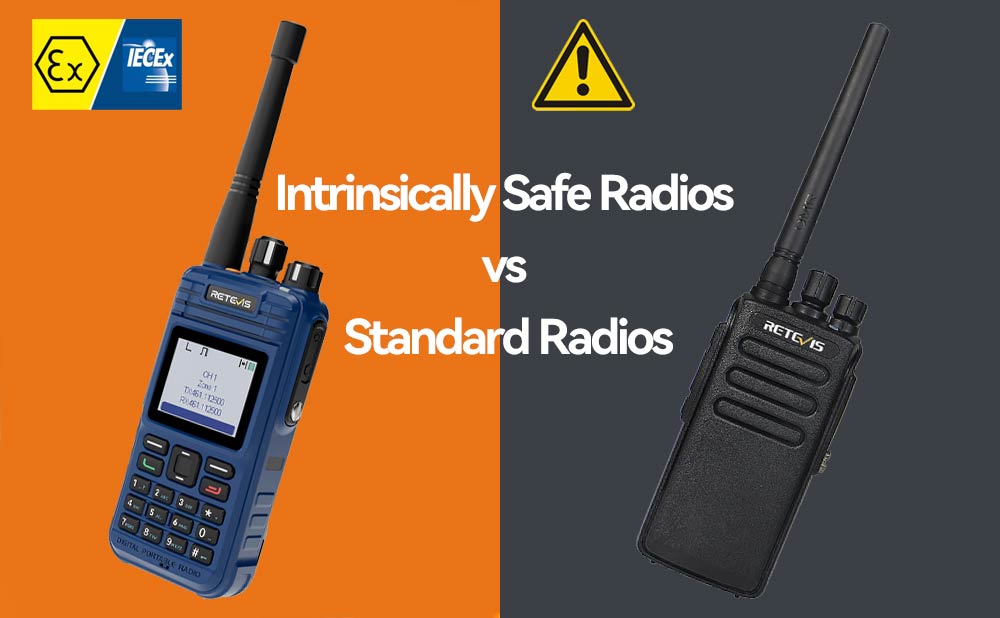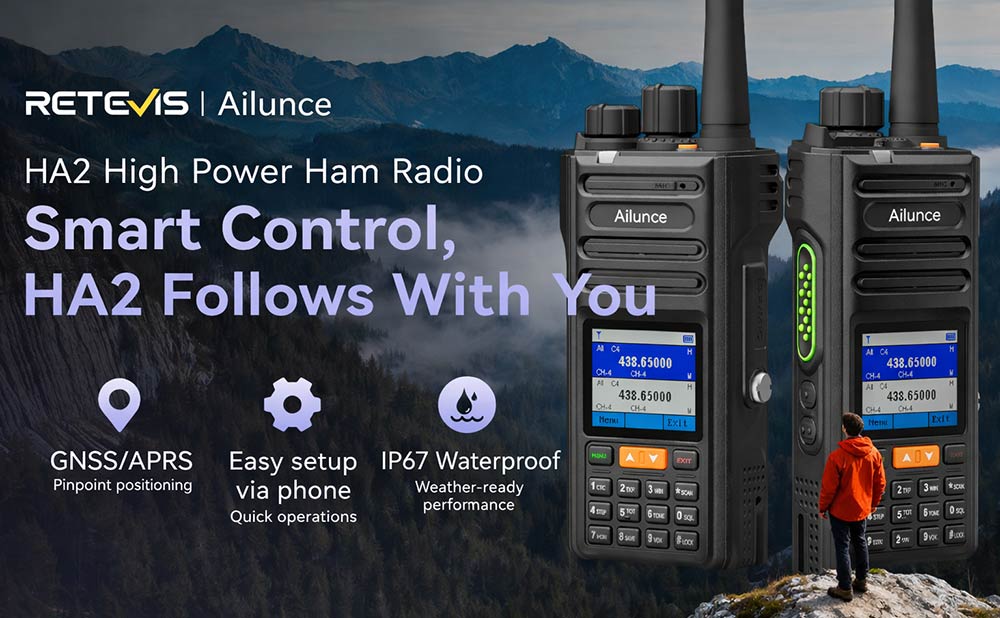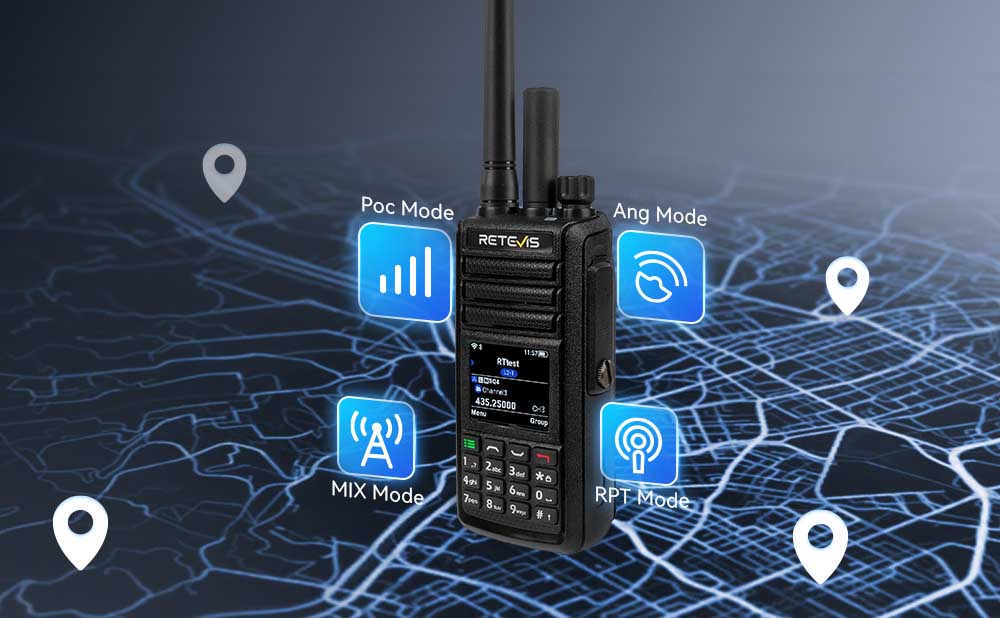Table of Contents
Intrinsically Safe Radios vs Standard Radios – What You Need to Know
- Posted by:Lucky
- 0 Comments

Not all radios are made equal when it comes to workplace communication. The radio you carry can literally save your life if there are sparks, flammable gases, or combustible dust on your jobsite. When choosing between a standard radio and an intrinsically safe radio in hazardous industries, safety, compliance, and team protection are more important considerations than performance.
Let's dissect the variations, examine the significance of intrinsically safe models, and take a look at some of the best choices from Retevis, a reputable manufacturer of professional-grade radios.
Where you’ll find IS radio essential?
An intrinsically safe (IS) radio is designed to function safely in dangerous situations. This indicates that its purpose is to: Prevent sparks, thereby removing the possibility of ignition in explosive environments. These radios often meet safety certifications like ATEX, IECEx, or similar, proving they’ve passed rigorous explosion-proof and environmental tests. They can be used in:
● Oil and gas facilities
● Chemical manufacturing plants
● Plastic production facilities with flammable dust or vapors
● Mining operations
● Pharmaceutical manufacturing
Simply put, if there’s any chance your work area could contain explosive gases or dust, intrinsically safe radios are non-negotiable.
Standard Radios—Reliable but Limited in Hazard Zones
Standard handheld radios are the everyday workhorses of communication. They’re used in:
● Warehouses
● Retail
● Security services
● Event coordination
They’re affordable, easy to use, and offer a wide range of features—but here’s the catch: they’re not built to prevent ignition in hazardous environments.
If you take a standard radio into a chemical mixing room or a dusty production floor where explosive particles could be in the air, you’re introducing a major risk. Even a small electrical spark or internal short could trigger a fire or explosion.
So while standard radios are fine for safe areas, they’re off the table for any industry that deals with flammable substances.
Core Differences Between Intrinsically Safe and Standard Radios
Here’s where they really part ways:
1. Safety Certification
● Intrinsically Safe Radios: Certified to meet explosion-proof standards like ATEX, IECEx, or local equivalents.
● Standard Radios: No explosion-proof certification; safe only for non-hazardous areas.
2. Build Materials & Sealing
● IS Radios: Use anti-static materials, rugged sealing to prevent dust/gas ingress.
● Standard Radios: Durable but may not be fully dustproof or anti-static.
3. Internal Circuit Design
● IS Radios: Circuits are designed to limit energy output, preventing ignition even if damaged.
● Standard Radios: No such limitation—potential ignition source in hazardous zones.
4. Durability Under Hazardous Conditions
● IS Radios: Withstand extreme conditions—high dust, humidity, and chemical exposure.
● Standard Radios: Built for durability but not for chemical or explosive resistance.
Why Choose Intrinsically Safe Radios in High-Risk Environments
It’s simple: safety first, always.
Here’s what an IS radio brings to the table:
● Explosion risk reduction—designed to avoid ignition sources.
● Regulatory compliance—meets workplace safety standards.
● Peace of mind—you know your team is protected in hazardous conditions.
● Operational continuity—reliable performance, even in extreme conditions.
For industries like plastic manufacturing, where flammable dust or fumes can be present, IS radios are more than a recommendation — they’re a requirement.
Retevis Intrinsically Safe Radios – Top Picks
Retevis Mate Talk E2 Explosion-proof Radio
If you need a digital intrinsically safe radio that blends modern tech with rugged safety, the Mate Talk E2 is a powerhouse:
● Intrinsically safe DMR two-way radio for hazardous environments.
● Compact and easy to carry during long shifts.
● Crystal-clear digital audio—even in noisy plants.
● Extended battery life to cover full workdays.
● Built tough for dust-heavy and explosive-prone work zones.
Best for: Plastic manufacturing, chemical plants, oil refineries, and any ATEX-like zone where safety is non-negotiable.
Choosing the Right Radio for Your Needs
Here’s a quick guide to deciding:
● If your work environment has any explosive risk: Go for an intrinsically safe model like the Mate Talk E2 Explosion-Proof radio.
● If you work in non-hazardous areas: A standard radio might be sufficient—but still choose a durable, long-lasting model.
● Consider:
○ Battery life—will it last a full shift?
○ Audio clarity—can it cut through background noise?
○ Ergonomics—is it easy to handle with gloves?
Discover more Retevis explosion-proof radio models here
Final Take – Safety Shouldn’t Be Optional
Choosing between an intrinsically safe radio and a standard radio isn’t just a technical decision—it’s about protecting lives, preventing disasters, and ensuring compliance.
If your workplace involves hazardous materials, there’s no question: an intrinsically safe radio is the only safe choice. And when it comes to reliability, rugged design, and proven safety, the Retevis E2 Explosion-Proof Radio stand out as smart, safety-first investments.
Your team’s safety is worth every penny. Don’t compromise—choose communication tools designed to protect as well as connect.






Comments
No data Yet